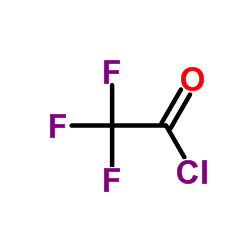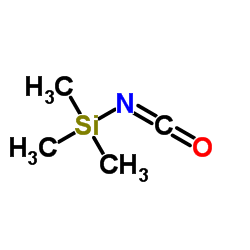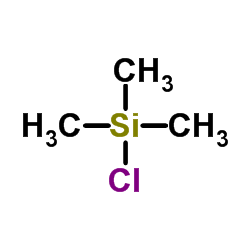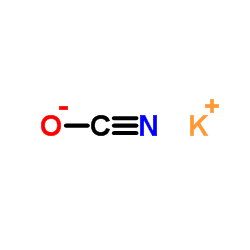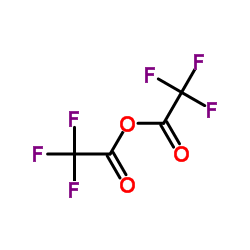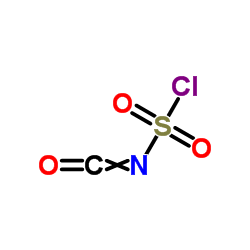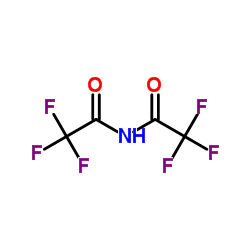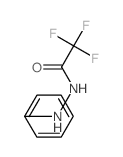14565-32-3
| 中文名 | 三氟乙酰基异氰酸酯 |
|---|---|
| 英文名 | 2,2,2-trifluoroacetyl isocyanate |
| 英文别名 |
Trifluormethylcarbonylaminocarbonyl
TRIFLUOROACETYLISOCYANATE Trifluoracetyl-isocyanat Trifluormethylcarbonyl-isocyanat |
| 密度 | 1.47g/cm3 |
|---|---|
| 沸点 | 39ºC at 760mmHg |
| 分子式 | C3F3NO2 |
| 分子量 | 139.03300 |
| 精确质量 | 138.98800 |
| PSA | 46.50000 |
| LogP | 0.41110 |
| 蒸汽压 | 447mmHg at 25°C |
| 折射率 | 1.37 |
Synonym:None Section 2 - COMPOSITION, INFORMATION ON INGREDIENTS
Risk Phrases: 36/37/38 Section 3 - HAZARDS IDENTIFICATION EMERGENCY OVERVIEW
Irritating to eyes, respiratory system and skin.Moisture sensitive.Stench. Potential Health Effects Eye: Causes eye irritation. Lachrymator (substance which increases the flow of tears). May cause chemical conjunctivitis. Skin: Causes skin irritation. May cause skin sensitization, an allergic reaction, which becomes evident upon re-exposure to this material. Ingestion: May cause gastrointestinal irritation with nausea, vomiting and diarrhea. The toxicological properties of this substance have not been fully investigated. Inhalation: Causes respiratory tract irritation. The toxicological properties of this substance have not been fully investigated. Exposure produces central nervous system depression. At high concentrations, isocyanates affect mucous membranes of the respiratory tract and may lead to fatal pulmonary edema. Exposure to low and often even unmeasurable isocyanate concentration results in sensitization. Chronic: May cause lung damage. Inhalation of product may aggravate existing chronic repiratory problems such as asthma, emphysema or bronchitis. Section 4 - FIRST AID MEASURES Eyes: Immediately flush eyes with plenty of water for at least 15 minutes, occasionally lifting the upper and lower eyelids. Get medical aid. Do NOT allow victim to rub eyes or keep eyes closed. Skin: Get medical aid. Flush skin with plenty of water for at least 15 minutes while removing contaminated clothing and shoes. Wash clothing before reuse. Ingestion: Never give anything by mouth to an unconscious person. Get medical aid. Do NOT induce vomiting. If conscious and alert, rinse mouth and drink 2-4 cupfuls of milk or water. Wash mouth out with water. Inhalation: Remove from exposure and move to fresh air immediately. If not breathing, give artificial respiration. If breathing is difficult, give oxygen. Get medical aid. Do NOT use mouth-to-mouth resuscitation. Notes to Physician: Treat symptomatically and supportively. Section 5 - FIRE FIGHTING MEASURES General Information: As in any fire, wear a self-contained breathing apparatus in pressure-demand, MSHA/NIOSH (approved or equivalent), and full protective gear. During a fire, irritating and highly toxic gases may be generated by thermal decomposition or combustion. Vapors may be heavier than air. They can spread along the ground and collect in low or confined areas. Runoff from fire control or dilution water may cause pollution. Extinguishing Media: Use water spray, dry chemical, carbon dioxide, or chemical foam. Do NOT get water inside containers. Section 6 - ACCIDENTAL RELEASE MEASURES General Information: Use proper personal protective equipment as indicated in Section 8. Spills/Leaks: Absorb spill with inert material (e.g. vermiculite, sand or earth), then place in suitable container. Clean up spills immediately, observing precautions in the Protective Equipment section. Provide ventilation. Do not get water inside containers. Section 7 - HANDLING and STORAGE Handling: Remove contaminated clothing and wash before reuse. Use with adequate ventilation. Avoid breathing dust, vapor, mist, or gas. Avoid contact with eyes, skin, and clothing. Keep container tightly closed. Do not allow contact with water. Keep from contact with moist air and steam. Storage: Store in a cool, dry place. Store in a tightly closed container. Store in a cool, dry, well-ventilated area away from incompatible substances. Store protected from moisture. Section 8 - EXPOSURE CONTROLS, PERSONAL PROTECTION Engineering Controls: Facilities storing or utilizing this material should be equipped with an eyewash facility and a safety shower. Use adequate ventilation to keep airborne concentrations low. Exposure Limits CAS# 14565-32-3: Personal Protective Equipment Eyes: Wear appropriate protective eyeglasses or chemical safety goggles as described by OSHA's eye and face protection regulations in 29 CFR 1910.133 or European Standard EN166. Skin: Wear appropriate protective gloves to prevent skin exposure. Clothing: Wear appropriate protective clothing to prevent skin exposure. Respirators: Follow the OSHA respirator regulations found in 29 CFR 1910.134 or European Standard EN 149. Use a NIOSH/MSHA or European Standard EN 149 approved respirator if exposure limits are exceeded or if irritation or other symptoms are experienced. Section 9 - PHYSICAL AND CHEMICAL PROPERTIES Physical State: Liquid Color: colorless Odor: stench pH: Not available. Vapor Pressure: Not available. Viscosity: Not available. Boiling Point: 37.5 deg C @ 760 mmHg Freezing/Melting Point: Not available. Autoignition Temperature: Not available. Flash Point: Not available. Explosion Limits, lower: Not available. Explosion Limits, upper: Not available. Decomposition Temperature: Solubility in water: Specific Gravity/Density: Molecular Formula: C3F3NO2 Molecular Weight: 139.04 Section 10 - STABILITY AND REACTIVITY Chemical Stability: Stable at room temperature in closed containers under normal storage and handling conditions. Conditions to Avoid: Moisture, excess heat. Incompatibilities with Other Materials: Strong oxidizing agents. Hazardous Decomposition Products: Hydrogen cyanide, nitrogen oxides, carbon monoxide, carbon dioxide, hydrogen fluoride gas, hydrocarbons. Hazardous Polymerization: Has not been reported Section 11 - TOXICOLOGICAL INFORMATION RTECS#: CAS# 14565-32-3 unlisted. LD50/LC50: Not available. Carcinogenicity: Trifluoroacetylisocyanate - Not listed by ACGIH, IARC, or NTP. Section 12 - ECOLOGICAL INFORMATION Section 13 - DISPOSAL CONSIDERATIONS Dispose of in a manner consistent with federal, state, and local regulations. Section 14 - TRANSPORT INFORMATION IATA Not regulated as a hazardous material. IMO Not regulated as a hazardous material. RID/ADR Not regulated as a hazardous material. Section 15 - REGULATORY INFORMATION European/International Regulations European Labeling in Accordance with EC Directives Hazard Symbols: XI Risk Phrases: R 36/37/38 Irritating to eyes, respiratory system and skin. Safety Phrases: S 26 In case of contact with eyes, rinse immediately with plenty of water and seek medical advice. S 37/39 Wear suitable gloves and eye/face protection. WGK (Water Danger/Protection) CAS# 14565-32-3: No information available. Canada None of the chemicals in this product are listed on the DSL/NDSL list. CAS# 14565-32-3 is not listed on Canada's Ingredient Disclosure List. US FEDERAL TSCA CAS# 14565-32-3 is not listed on the TSCA inventory. It is for research and development use only. SECTION 16 - ADDITIONAL INFORMATION N/A |
| 海关编码 | 2929109000 |
|---|
|
~38% 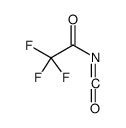
14565-32-3 |
| 文献:Arbuzov, B. A.; Zobova, N. N.; Andronova, I. I. Izvestiya Akademii Nauk SSSR, Seriya Khimicheskaya, 1974 , p. 1484 - 1487 Izvestiya Akademii Nauk SSSR, Seriya Khimicheskaya, 1974 , p. 1566 - 1570 C.A., 1974 , vol. 81, p. 169072 |
|
~65% 
14565-32-3 |
| 文献:Kiemstedt, Wolfgang; Sundermeyer, Wolfgang Chemische Berichte, 1982 , vol. 115, # 3 p. 919 - 925 |
|
~% 
14565-32-3 |
| 文献:Barrett, Anthony G. M.; Betts, Michael J.; Fenwick, Ashley Journal of Organic Chemistry, 1985 , vol. 50, # 2 p. 169 - 175 |
|
~36% 
14565-32-3 |
| 文献:Firth, W. C. Journal of Organic Chemistry, 1968 , vol. 33, p. 441 - 442 Full Text View citing articles Show Details American Cyanamid Comp. Patent: US3541120 , 1970 ; C.A., 1971 , vol. 74, p. 31545 |
|
~% 
14565-32-3 |
| 文献:Ye; Noftle Journal of Fluorine Chemistry, 1997 , vol. 81, # 2 p. 193 - 196 |
|
~% 
14565-32-3 |
| 文献:Ye; Noftle Journal of Fluorine Chemistry, 1997 , vol. 81, # 2 p. 193 - 196 |
|
~% 
14565-32-3 |
| 文献:Durig, J. R.; Guirgis, G. A.; Krutules, K. A. Journal of Molecular Structure, 1994 , vol. 328, p. 55 - 76 |
| 上游产品 9 | |
|---|---|
| 下游产品 5 | |
| 海关编码 | 2929109000 |
|---|---|
| 中文概述 | 2929109000. 其他异氰酸酯. 增值税率:17.0%. 退税率:13.0%. 监管条件:无. 最惠国关税:6.5%. 普通关税:30.0% |
| 申报要素 | 品名, 成分含量, 用途 |
| Summary | 2929109000. other isocyanates. VAT:17.0%. Tax rebate rate:13.0%. . MFN tariff:6.5%. General tariff:30.0% |




